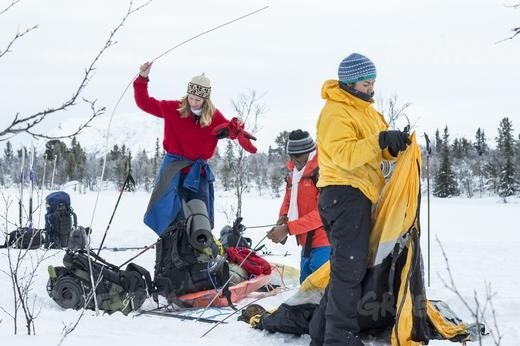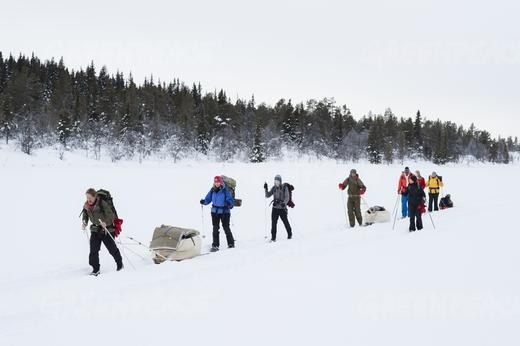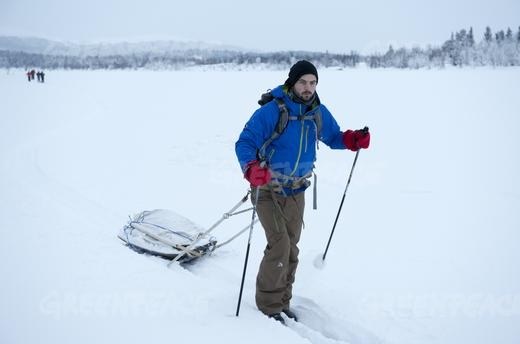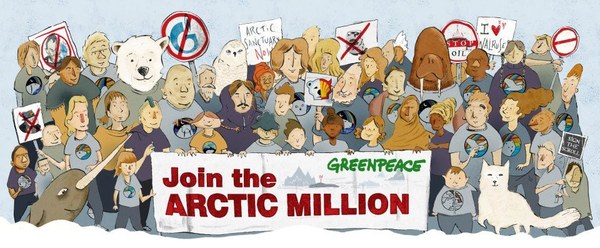All news: 15 February 2013
Lyudmila Korobeshko in the star team of Greenpeace goes to the North Pole
North Pole.
From the 1st to the 5th of February in the legendary village of Vinstra, Norway, Greenpeace held a training camp. The members of team are preparing to commit a ski expedition to the North Pole, which will be held in April this year. Vinstra ...
From the 1st to the 5th of February in the legendary village of Vinstra, Norway, Greenpeace held a training camp. The members of team are preparing to commit a ski expedition to the North Pole, which will be held in April this year. Vinstra village is famous because there trained famous Amundsen. Now the team from all the world was here. In April, these people will get to the North Pole so-called "time capsule." Read about it below.
Director of the 7 Summits Club Lyudmila Korobeshko will represent Russia in the expedition. She was in the training camp.
Greenpeace action was supported by more than 2.55 million people. These include musician Paul McCartney, rock band Radiohead and actor Jude Law. They all believe that the Arctic – it is not a place for the oil industry, commercial fishing, and war, and the area around the North Pole must become a worldwide wildlife sanctuaries.
Names people signed the document will be printed on the plate of an inert metal and placed in 17-inch glass "time capsule." In April 2013, an international expedition of Greenpeace delivers a capsule to the North Pole, where it will be sunk to the bottom of the Arctic Ocean. At the dive site, they set a flag of the “capsules Future”, symbolizing peace and hope. The flag will be created by children: in the competition for the best design it involves thousands of students from around the world.
Greenpeace intends to raise the capsule in 2050, by which time we will know whether mankind could save the Arctic.
The collection of signatures in support of the Arctic will continue on, they will be used in negotiations with politicians from different countries on the establishment of the reserve in the Arctic.
FREQUENTLY ASKED QUESTIONS
WHAT’S THIS CAMPAIGN ABOUT?
We’re coming together to push for action to save the Arctic. That means creating a global sanctuary in the uninhabited area around the North Pole (the region some people call the High Arctic) and a ban on offshore oil drilling and industrial fishing in the wider Arctic region.
WHAT’S A GLOBAL SANCTUARY?
It’s an area of the globe under legal protection that’s off-limits to the polluters – a place dedicated to science and research. In Antarctica – at the other end of the Earth – a World Park was declared, so the destructive mining industry can’t operate there. We’re going to create something similar at the top of the world. Right now it belongs to all of us, it’s classified as the High Seas and the international seabed, but the Arctic states are submitting claims, saying it’s their territory. They want to open up the seabed to the polluters, so before the countries and corporations can get their hands on it, we’re going to secure it for all life on Earth.
AND THE FIRST STEP IS A UN RESOLUTION?
World leaders gather every September at the UN HQ in New York. We want them to pass a UN resolution demanding legal protection for the Arctic. That means persuading more than half the world’s governments that this needs to happen. A resolution at the UN General Assembly would create the momentum we need to push for an agreement to create the sanctuary and a ban on offshore oil drilling and unsustainable industrial fishing in the region.
HOW WILL YOU TAKE MY NAME TO THE NORTH POLE?
When you sign the petition, your name will be added to an Arctic scroll with the names of others who have joined our movement to defend the Arctic. In April of 2013, we will embark on an expedition to the North Pole. When we get there, we’ll place the scroll of names in a time capsule and lower it through the ice and 4km of freezing water to the seabed. Wherever you are, you’ll know when you look north that your name is planted permanently on the bottom of the ocean at the top of the world as a statement of your commitment to protect the Arctic.
WHAT IS THE FLAG FOR THE FUTURE?
When we plant the time capsule at the North Pole, we’ll also mark the spot with a Flag for the Future, designed by the youth of the world in a global competition. This flag represents our joint commitment to save the Arctic and sends a message of peace, hope, and global community to the world. Greenpeace is currently working with the Worldwide Association of Girl Guides and Girl Scouts to run the competition to design the flag. The competition runs until February 2013. The designs will then be judged by a panel including fashion designer Vivienne Westwood in March 2013. For more information about how to enter, please visitwww.flagforthefuture.org.
WHEN WILL THE EXPEDITION TO THE NORTH POLE TAKE PLACE, AND HOW CAN I FOLLOW IT?
The expedition will take place in early April 2013 and last for approximately five days. Our expedition party will include representatives from around the world and we will record and share their journey.
WON’T LEAVING THE TIME CAPSULE ON THE SEAFLOOR BE LITTERING?
Not at all. We've been working with experts to make a capsule that will stand the test of time without disturbing this amazing marine environment. It will take the form of a 17 inch sphere made from a material similar to glass. It will lie, immobile, on the seafloor, and will be completely non-toxic. As a sphere there will be nothing on its surface to catch or injure nearby wildlife. The names on the scroll inside will be recorded on similarly inert materials such as crystal, gold or platinum. We aim for the capsule to be retrieved in 2050; until then, it will rest peacefully beneath the ice in harmony with its environment, preserved for future generation.
WHAT WILL THIS SCROLL ACTUALLY ACHIEVE - ISN’T IT JUST A SYMBOLIC THING?
This scroll is a way of giving normal people a stake in the future of the Arctic. It’s a symbol of international cooperation winning out over corporate greed and short term national interests.
The countries trying to carve up the Arctic for fossil fuels understand the power of symbolism. That’s why the explorer Artur Chillingarov planted a Russian flag on the seabed beneath the pole in 2007. When people sign up to our campaign they will know that their name will be taken to the North Pole and planted there in defiance of this greedy carve up, and that’s a powerful reason for them to join the movement.
As well as being a physical manifestation of this movement, it will also contain information that we hope will be used by the campaigners and communicators of the future. We’re working on ways to allow people to leave messages to the future within it.
More information:
http://rising.savethearctic.org/en/pages/faq
How the Soviet Army ousted Nazis from Elbrus
Elbrus.
On February 13 and 17, 1943 Soviet mountain infantry troops ascended Elbrus to throw off Hitler's flags that had been previously placed there by the German Edelweiss division and put the Soviet flags above Europe's highest mountain peaks. ...
On February 13 and 17, 1943 Soviet mountain infantry troops ascended Elbrus to throw off Hitler's flags that had been previously placed there by the German Edelweiss division and put the Soviet flags above Europe's highest mountain peaks.
In the spring of 1942 after his failure to seize Moscow Hitler focused on the southern flank of the Soviet-German front. A fierce battle for the Caucasus began. Hitler sought control of the region’s oil resources, says Mikhail Myagkov, expert at the Institute of General History of the Russian Academy of Sciences.
“By seizing control of the oil fields in Baku and Grozny Hitler would have been able to unleash a global war that could have lasted for decades. In August-September of 1942 German Army Group A led by field marshal List with support of the Romanian troops was on its way to the Caucasus in order to win control of the Malgobek and Mozdok passes, as well as the town of Vladikavkaz.”
In August of 1942 the Berlin Radio reported: “Germany’s flag is waving above the highest peak of the Caucasus. Brave soldiers of the 1st Edelweiss division have placed the symbol of the German military glory on Mount Elbrus.”
The coverage of the battles taking place in the Caucasus controlled by Reich Minister of Propaganda Goebbels sounded like the country’s victory over the Soviets. But this turned out to be an illusion. In late December of 1942 the Red Army troops and the Soviet Air Forces launched a counter-offensive against Army Group A. To avoid a defeat the Nazi troops had to flee the Caucasus. On February 4, 1943, the Soviet mountain infantry troops were ordered to examine the abandoned German camps on Elbrus and replace the Nazi flags with Soviet ones. The operation was led by renowned athlete Alexander Gusev. Twenty soldiers divided into three groups to fulfill the task.
Expert at the museum of the Sports and Physical Training Institute Irina Didiguriya: “They did not have any uniform, just the basic equipment needed for alpine climbing. They also had padded jackets and automatic guns. The ascension took them several days because a team of 11 alpine climbers that had operated before the war no longer existed at the time.”
The ascension was not affected by snowfalls or freezing wind. The Elbrus West dome, which is 5,642 m high, was reached on February 13. The mount's East dome (5,421 m high) was ascended four days later. Many monuments were placed near Elbrus in memory of WW II heroes.
http://english.ruvr.ru/2013_02_12/How-the-Soviet-Army-ousted-Nazis-from-Elbrus/










